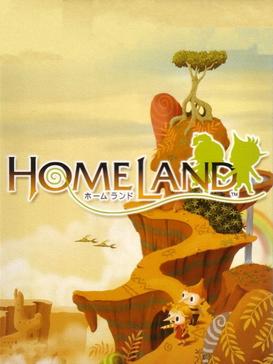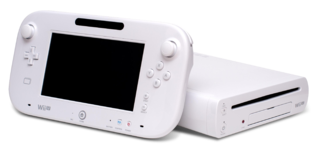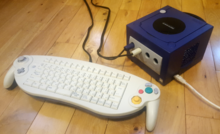
The Game Boy Advance (GBA) is a 32-bit handheld game console developed, manufactured and marketed by Nintendo as the successor to the Game Boy Color. It was released in Japan on March 21, 2001, in North America on June 11, 2001, in the PAL region on June 22, 2001, and in mainland China as iQue Game Boy Advance on June 8, 2004.

The GameCube is a home video game console developed and marketed by Nintendo. It was released in Japan on September 14, 2001, in North America on November 18, 2001, in Europe on May 3, 2002, and in Australia on May 17, 2002. It is the successor to the Nintendo 64 (N64) and the predecessor to the Wii. As a sixth-generation console, the GameCube primarily competed with the PlayStation 2 and Xbox.

Shigeru Miyamoto is a Japanese video game designer, producer and game director at Nintendo, where he serves as one of its representative directors as an executive since 2002. Widely regarded as one of the most accomplished and influential designers in video games, he is the creator of some of the most acclaimed and best-selling game franchises of all time, including Mario,The Legend of Zelda, Donkey Kong, Star Fox and Pikmin. More than 1 billion copies of games featuring franchises created by Miyamoto have been sold.

The Legend of Zelda: Ocarina of Time is a 1998 action-adventure game developed and published by Nintendo for the Nintendo 64. It was released in Japan and North America in November 1998 and in PAL regions the following month. Ocarina of Time is the first game in The Legend of Zelda series with 3D graphics.

The 64DD is a magnetic floppy disk drive peripheral for the Nintendo 64 game console developed by Nintendo. It was announced in 1995, prior to the Nintendo 64's 1996 launch, and after numerous delays was released in Japan on December 13, 1999. The "64" references both the Nintendo 64 console and the 64 MB storage capacity of the disks, and "DD" is short for "disk drive" or "dynamic drive".

Phantasy Star Online is an online role-playing game (RPG) developed by Sonic Team and published by Sega in 2000 for the Dreamcast. It was the first online RPG for game consoles; players adventure with up to three others over the internet to complete quests, collect items and fight enemies in real-time action RPG combat. The story is unrelated to previous games in the Phantasy Star series.

Mario Kart: Double Dash!! is a 2003 kart racing video game developed and published by Nintendo for the GameCube (GCN). This game is the fourth main entry in the Mario Kart series, following Mario Kart: Super Circuit (2001), Mario Kart 64 (1996), and Super Mario Kart (1992). Similar to the previous titles, Double Dash!! challenges Mario series player characters to race against each other on Mario-themed tracks. The game introduced a number of new gameplay features, such as supporting co-op gameplay with two riders per kart. One player drives the kart and the other uses items, hence the game's title. Players can switch at any time. Double Dash!! is the only game in the Mario Kart series to allow cooperative gameplay so far. Double Dash!! supports LAN play using the Nintendo GameCube Broadband Adapter, allowing up to 16 players to compete simultaneously. There are 20 characters to select from in total, each of which with a special item, and with eleven characters being new to the series.

The Wii is a home video game console developed and marketed by Nintendo. It was released on November 19, 2006 in North America, and in December 2006 for most other regions of the world. It is Nintendo's fifth major home game console, following the GameCube and is a seventh-generation console alongside Microsoft's Xbox 360 and Sony's PlayStation 3.
In the history of video games, the sixth generation era is the era of computer and video games, video game consoles, and handheld gaming devices available at the turn of the 21st century, starting on November 27, 1998. Platforms in the sixth generation include consoles from four companies: the Sega Dreamcast (DC), Sony PlayStation 2 (PS2), Nintendo GameCube (GC), and Microsoft Xbox. This era began on November 27, 1998, with the Japanese release of the Dreamcast, which was joined by the PlayStation 2 on March 4, 2000, the GameCube on September 14, 2001 and the Xbox on November 15, 2001, respectively. On March 31, 2001, the Dreamcast was among the first to be discontinued. Xbox in 2006, GameCube in 2007 and PlayStation 2 was the last, in January 2013. Meanwhile, the seventh generation of consoles started on November 22, 2005, with the launch of the Xbox 360.

The Dreamcast is a home video game console by Sega, the first one introduced in the sixth generation of video game consoles. With the release of the Dreamcast in 1998 amid the dot-com bubble and mounting losses from the development and introduction of its new home console, Sega made a major gamble in attempting to take advantage of the growing public interest in the Internet by including online capabilities in the console as a selling point. As such, the Dreamcast was the first console to include a built-in modem for Internet support and online play. Sega would end up leaning heavily into the online capabilities to sell the Dreamcast as hype grew for Sony's then-upcoming competitor, the PlayStation 2, which also promised online gaming in addition to its DVD capabilities.

Homeland is a role-playing video game for the GameCube developed and published by Chunsoft, and was released in Japan on April 29, 2005.

The Wii system software is a discontinued set of updatable firmware versions and a software frontend on the Wii home video game console. Updates, which could be downloaded over the Internet or read from a game disc, allowed Nintendo to add additional features and software, as well as to patch security vulnerabilities used by users to load homebrew software. When a new update became available, Nintendo sent a message to the Wii Message Board of Internet-connected systems notifying them of the available update.

The GameCube controller is the standard game controller for the GameCube home video game console, manufactured by Nintendo and launched in 2001. As the successor to the Nintendo 64 controller, it is the progression of Nintendo's controller design in numerous ways. The contentious M-shaped design of its predecessor was replaced with a more conventional handlebar style controller shape; a second analog stick was added, replacing the C buttons with a C stick and the X and Y face buttons, last seen on the Super Nintendo controller, were reintroduced; the shoulder buttons were changed to hybrid analog triggers. A wireless variant of the GameCube controller known as the WaveBird was released in 2002.
Online games are video games played over a computer network. The evolution of these games parallels the evolution of computers and computer networking, with new technologies improving the essential functionality needed for playing video games on a remote server. Many video games have an online component, allowing players to play against or cooperatively with players across a network around the world.

The Japanese multinational consumer electronics company Nintendo has developed seven home video game consoles and multiple portable consoles for use with external media, as well as dedicated consoles and other hardware for their consoles. As of September 30, 2021, in addition to Nintendo Switch, Nintendo has sold over 863.07 million hardware units.
GameCube accessories include first-party releases from Nintendo, and third-party devices, since the GameCube's launch in 2001.

Mario is a Japanese multimedia franchise created by Japanese game designer Shigeru Miyamoto for video game company Nintendo which produces and publishes its installments. Starring the titular Italian plumber Mario, it is primarily a video game franchise, but has extended to other forms of media, including television series, comic books, a 1993 feature film, a 2023 animated film and theme park attractions. The series' first installment was 1983's Mario Bros., although Mario had made his first appearance in 1981's arcade game Donkey Kong, and had already been featured in several games of the Donkey Kong and Game & Watch series. The Mario games have been developed by a wide variety of developers including Nintendo, Hudson Soft, and AlphaDream. Mario games have been released almost exclusively for Nintendo's various video game consoles and handhelds, from the third generation onward.

The Wii U is a home video game console developed by Nintendo as the successor to the Wii. Released in late 2012, it is the first eighth-generation video game console and competed with Microsoft's Xbox One and Sony's PlayStation 4.
Online console gaming involves connecting a console to a network over the Internet for services. Through this connection, it provides users the ability to play games with other users online, in addition to other online services.

The Nintendo Switch is a video game console developed by Nintendo and released worldwide in most regions on March 3, 2017. Released in the middle of the eighth generation of home consoles, the Switch succeeded the Wii U and competed with Microsoft's Xbox One and Sony's PlayStation 4; it also competes with the ninth-generation consoles, Microsoft's Xbox Series X/S and Sony's PlayStation 5.


















